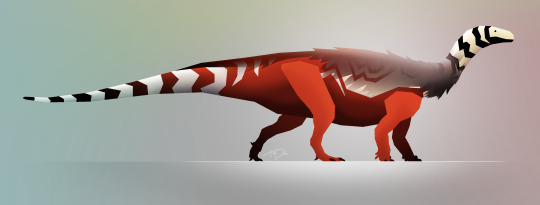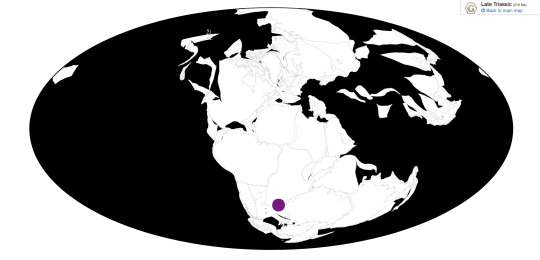#melanorosaurus readi
Explore tagged Tumblr posts
Text

Melanorosaurus readi is a massive basal sauropodomorph known from the Lower Elliot Formation (Late Triassic of South Africa). Many bones of South African sauropodomorphs have been attributed to this taxon, but some of them may belong to other animals. For example, the skull described in 2007 comes from the Early Jurassic Upper Elliot formation, so its attribution to Melanorosaurus is questionable. This year, a re-description of the taxon and clarification of the ownership of its remains were published: www.tandfonline.com/doi/full/1 … Melanorosaurus reached a length of 8 m. The massive bones of the limbs indicate the four-legged nature of this animal. It belongs to the Sauropodiformes group, from which the true sauropods descended.
Paint 3D, 2024.
#melanorosaurus#lessemsaurus#sauropodiform#sauropodomorph#lower elliot formation#late triassic#paleoart#paint 3d
24 notes
·
View notes
Text

Two male Melanorosaurus readi eyeing each other in late Triassic South Africa. From my book ”De första dinosaurierna” (”The first dinosaurs”)
#dinosaur#illustration#triassic#paleoart#paleontology#paleoillustration#paleoblr#art#sauropodomorph#palaeoart#palaeoblr#palaeontology
145 notes
·
View notes
Text
Melanorosaurus readi

By Tas Dixon
Etymology: Black Mountain Reptile
First Described By: Haughton, 1924
Classification: Dinosauromorpha, Dinosauriformes, Dracohors, Dinosauria, Saurischia, Eusaurischia, Sauropodomorpha, Bagualosauria, Plateosauria, Massopoda, Sauropodiformes, Anchisauria, Melanorosauridae
Time and Place: From 210 until 201 million years ago, possibly into the Jurassic, from the Norian through the Rhaetian (and possibly into the Hettangian) of the Late Triassic

Melanorosaurus is known from the Lower Elliot (and, maybe, the Upper Elliot) Formation of South Africa

Physical Description: Melanorosaurus was a later Sauropodomorph, the group of dinosaurs that includes Sauropods and their close relatives (aka, “Prosauropods”). Melanorosaurus was technically not a Sauropod, but it does highlight how these quadrupedal behemoths evolved from basic dinosaur precursors. It was quadrupedal, but with awkward front feet still retaining hand-like qualities of its forefathers. The hindlimbs were more sturdy, and in general the pillar-like proportions of the limbs helped to hold up its great weight. It was probably up to 8 meters long and 2 meters tall, making it one of the heaviest animals in its environment - weighing about 1.3 tons. It had a pointed, triangular snout, and teeth like earlier Prosauropods rather than proper Sauropods. It had a short neck and long tail, with a very thick trunk. As for external appearance, there is a question - it was small enough, just, to still have fluff, but it also was big enough to have lost it in the interest of keeping cool. Given it lived in a particularly hot climate, it makes sense that some - if not all - of the warm fluff of its ancestors may have been shed off. That said, it also lived southward - so it’s possible that the Elliot had a cooler environment than other places of the Late Triassic. All in all, the fluff status of Melanorosaurus is a question, so here we present it fluffy to some extent, since most interpretations of it are scaly.
Diet: Melanorosaurus would have been an herbivore, but it may have fed occasionally on small animals to supplement its diet, especially since Melanorosaurus had the teeth of its omnivorous precursors.

By Ripley Cook
Behavior: Melanorosaurus was a smaller Sauropodomorph, so it probably would have taken care of its young (like its close relative Massospondylus) in nests and potential family structures. These nests are hypothetical, however, so we can’t say what sort of lifestyle Melanorosaurus would have lead in this regard. It probably would have stuck together in herds for safety from large contemporaneous predators, and moved together across the dry landscape of their environment looking for new sources of food. Given they managed to survive the end-Triassic extinction (probably), this was clearly a successful strategy to some extent. Their short necks means that they probably would have had to feed mainly on low-lying vegetation, though it is entirely likely that they could have reared on their hind limbs in order to reach higher sources of food. Since they still had some traits of bipedality (likely vestigial), this seems more likely than not.
Ecosystem: The Elliot Formation was a highly arid sub-tropical desert, filled with hearty conifers (which did a lot of the desert-plant jobs before cacti evolved) lining seasonal rivers that would dry up come the long harsh season. It was cooler than other places in the Triassic, but still quite hot and harsh, making it a baking environment for the creatures that lived there. The exact composition of each environment - the Lower Triassic part of the environment and the Upper Jurassic part - is difficult to determine, because the levels tend to be hard to define, but some work has been done on this in recent years. Other Sauropodomorphs included Plateosauravus, Eucnemesaurus, and Bikanasaurus - so, some not very well preserved species, making Melanorosaurus an exception in this region. There was also the Mammaliaform Elliotherium and the Dicynodont Pentasaurus. However, literally every other example of creature seems to be from the Upper Elliot, so it is uncertain what the predators of Melanorosaurus would have been.

By José Carlos Cortés
Other: Melanorosaurus is such an almost-Sauropod that its description and study often threatens to redefine exactly what it means to be a Sauropod or… not. As such, Melanorosaurus is literally defined out of Sauropoda, with Sauropods defined as those members of the sauropod-y group more closely related to Saltasaurus than to Melanorosaurus. That said, Melanorosaurus has a significant amount of similarities to later Sauropods, one of the weirder and more magnificent experiments of Triassic dinosaurs - and a sign of the scale of dinosaurs to come after this period of experimentation ends.
~ By Meig Dickson
Sources Under the Cut
Fabrègues, P. C. d., R. Allain. 2016. New material and revision of Melanorosaurus thabanensis, a basal sauropodomorph from the Upper Triassic of Lesotho. PeerJ 4: e1639.
Galton, P. M., P. Upchurch. “Prosauropoda”. In D. B. Weishampel, P. Dodson, & H. Osmólska (eds.). 2004. The Dinosauria (second edition). University of California Press, Berkeley 232 - 258.
Galton, P. M., J. Van Heerden, A. M. Yates. 2005. Postcranial Anatomy of Referred Specimens of the Sauropodomorph Dinosaur Melanorosaurus from the Upper Triassic of South Africa. Tidwell, V. & K. Carpenter (eds.)Thunder-Lizards: The Sauropodomorph Dinosaurs. Indiana University Press.
Gauffre, F. X. 1993. The most recent Melanorosauridae (Saurischia, Prosauropoda), Lower Jurassic of Lesotho, with remarks on the prosauropod phylogeny. Neues Jahrbuch für Geologie und Paläontologie Monatshefte. 1993 (11): 648 - 654.
Haughton, S. H. 1924. The fauna and stratigraphy of the Stormberg Series. Annals of the South African Museum 12: 323 - 497.
McPhee, B. W., J. N. Choiniere, A. M. Yates and P. A. Viglietti. 2015. A second species of Eucnemesaurus Van Hoepen, 1920 (Dinosauria, Sauropodomorpha): new information on the diversity and evolution of the sauropodomorph fauna of South Africa's lower Elliot Formation (latest Triassic). Journal of Vertebrate Paleontology 35(5):e980504:1-24.
McPhee, B. W., E. M. Bordy, L. Sciscio, J. N. Choiniere. 2017. The sauropodomorph biostratigraphy of the Elliot Formation of southern Africa: Tracking the evolution of Sauropodomorpha across the Triassic–Jurassic boundary. Acta Palaeontologica Polonica 62 (3): 441 - 465.
Paul, G. S. 2010. The Princeton Field Guide to Dinosaurs. Princeton University Press: 170.
Yates, A. M. 2007. The first complete skull of the Triassic dinosaur Melanorosaurus Haughton (Sauropodmorpha: Anchisauria), in Barrett, P. M. & D. J. Batten. Special Papers in Paleontology 77: 9 - 55.
Yates, A. M. 2010. A revision of the problematic sauropodomorph dinosaurs from Manchester, Connecticut and the status of Anchisaurus Marsh. Palaeontology 53 (4): 739 - 752.
#melanorosaurus#melanorosaurus readi#palaeoblr#triassic#dinosaur#prosauropod#sauropodomorph#reptile#prehistoric life#paleontology#triassic madness#triassic march madness
337 notes
·
View notes
Photo

Animatronic Melanorosaurus readi from Heureka’s The Giant Dinosaurs exhibit
35 notes
·
View notes
Video
youtube
Animatronic Melanorosaurus readi
25 notes
·
View notes
Text
Melanorosaurus readi, M. thabanensis

Source: fireflysummers! She reblogs a wide variety of typical tumblr activities, from funny posts to fandoms and cute animals, as well as different kinds of art and guides on how to do different types of illustrations. Definitely worth a look, so go check out her blog!
Name: Melanorosaurus readi, M. thabanensis
Name Meaning: Black Mountain Reptile
First Described: 1924
Described By: Haughton
Classification: Dinosauria, Saurischia, Eusaurischia, Sauropodomorpha, Plateosauria, Massopoda, Sauropodiformes, Anchisauria, Melanorosauridae
Melanorosaurus was a sauropodmorph from the Lower Elliot Formation in South Africa, dating back to the Norian age of the Late Triassic, betwen 216.5 and 189.6 million years ago. It is known from a complete skull and partial other remains. It was intermediate in its morphology between early “prosauropods” and the sauropods, and was about 8 meters long and more than 2 meters tall. It had sturdy limbs, allowing it to walk quadrupedally. It was probably an herbivore, and one of the largest land animals of its day.
Sources:
https://en.wikipedia.org/wiki/Melanorosaurus
http://www.prehistoric-wildlife.com/species/m/melanorosaurus.html
Shout out goes to taylorewwitt!
#melanorosaurus#melanorosaurus readi#melanorosaurus thabanensis#dinosaur#prosauropod#fireflysummers#taylorewwitt#dinosaurs#a dinosaur a day#a-dinosaur-a-day#dinosaur of the day#dinosaur-of-the-day#science#nature#biology#paleontology#prehistoric life#prehistory#factfile
64 notes
·
View notes